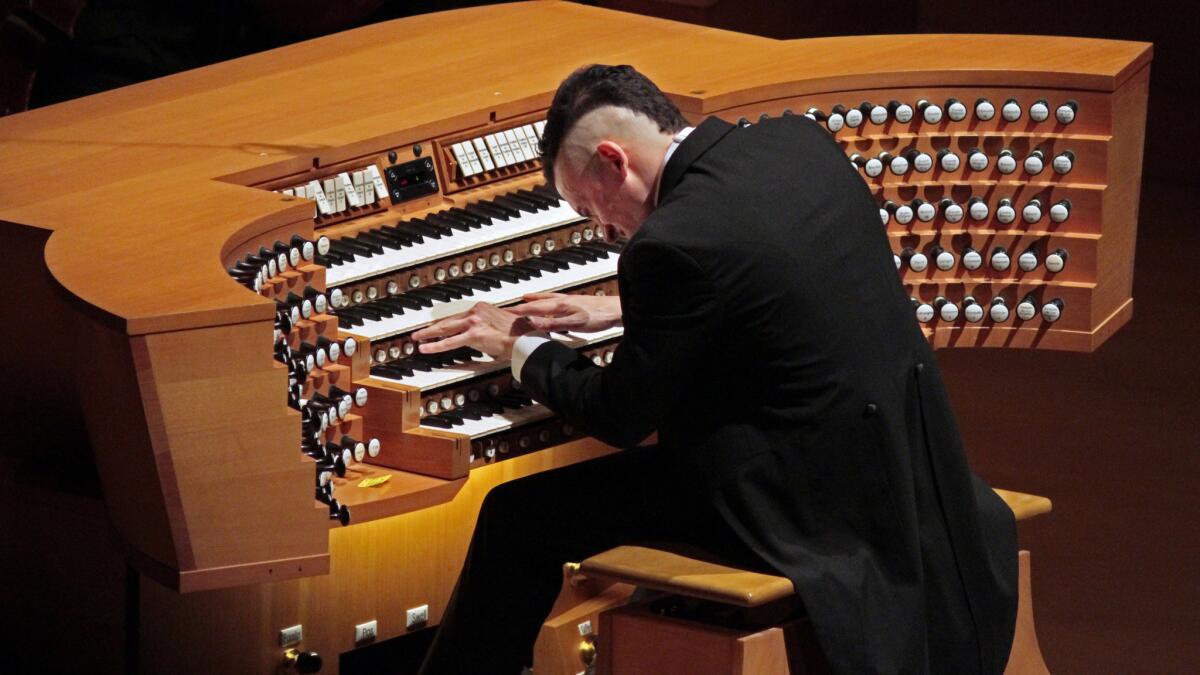Review: Hurricane Mama’s impressive set of pipes

- Share via
With its jutting wood pipes, the Walt Disney Concert Hall organ is visually king of the king of instruments. It is, in addition, a sonically and palpably present organ tuned for the hall’s clear, pure and tactile acoustics. The composer Terry Riley dubbed it Hurricane Mama for a reason.
Yet what makes this mighty organ special is how much an ordinary organ it really is. The shape of those striking “French fry” pipes doesn’t affect the sound, but it helps focus our attention.
Meanwhile, Mama’s majesty, vibrant sonic color and incomparable low notes that vibrate the floor are heard, seen and felt in Disney as organ essence, an organ drug that takes control of your body and mind. You can always tell the organists in the audience — they love nothing better than to take off their shoes and let the organ pulse through their feet.
The Los Angeles Philharmonic’s “Happy Birthday Hurricane Mama” celebration of the organ’s 10th anniversary (the organ wasn’t ready for use until the hall’s second season) is reaching its climax this week. Thursday was the first night of Gustavo Dudamel’s subscription program featuring Cameron Carpenter as soloist, and the organ in every work. The birthday party concludes Sunday evening with a multi-organist recital.
Thursday’s orchestral program — repeated Saturday afternoon at Disney and Sunday afternoon at Renée and Henry Segerstrom Concert Hall (which also has a notable organ) — began and ended with two splashy pieces that are regularly trotted out to show off an organ. But what came before and between Samuel Barber’s Toccata Festiva and Saint-Saëns’ Symphony No. 3 (“Organ”) was eccentric.
Carpenter replaced the usual pre-concert Upbeat Live talk with a riveting, if peculiar, 25-minute recital. For the main concert, he followed the Barber Toccata with his solo organ transcription of Scriabin’s Piano Sonata No. 4, a curiosity in and of itself and an even greater one in the midst of an otherwise organ and orchestra program.
Finally there was another Fourth, the premiere of Stephen Hartke’s Symphony No. 4 for soprano, organ and orchestra. A long time coming, it had been scheduled for the orchestra’s 2009-’10 season but wasn’t finished in time. It is an almost 35-minute score with big ambitions by a Los Angeles composer with a considerable national reputation but whose music isn’t heard as much as you would expect it to be in our city.
The real center of attention was Carpenter. An extraordinary virtuoso and thinking musician, he demonstrates a unique and increasingly compelling combination of flash and substance. He tends to dress with a little help from Swarovski. In immaculately tailored concert tail, he allowed only discrete touches of glitter to show. But a feline dark strip of hair over a shaved head made him look, especially from the back as he was seated at the console, like a wild organ animal ready to pounce.
In the pre-concert recital he pounced on Bach’s Trio Sonata No. 3, which he gave a startlingly nasal near-nastiness, and on an excerpt from Messiaen’s “La Nativitè du Seigneur,” so rich and effusive that it was simply the most overwhelming Messiaen organ playing I’ve ever encountered.
He then tore into Barber’s Toccata, an empty piece but with lots for the organ to do, while Dudamel tore into the orchestral part, making the L.A. Phil sound like a giant extension of the organ. Carpenter’s gothic, spookily tinted organ transcription of Scriabin’s mystic short sonata proved then a useful corrective for Barber’s bluster.
Hartke does not call the organ part in his new symphony a solo but rather uses it as part of the orchestra. Hence, the organist was here the L.A. Phil’s principal keyboard player, Joanne Pearce Martin. Still, the organ proved important enough that it would have been nice for her to have gotten a credit in the program.
The symphony begins with large, heavy chords and somber, dark melodic ideas. In his best pieces, Hartke has a way of finding modern contexts for ancient music and a nimble textural touch. Here, though, there is considerable thickness of Brahms. In a scherzo section, about 10 minutes in, brighter colors suddenly appear. The organ and orchestra almost exchanges roles — sparkles of flute and metallic percussion coming from the organ pipes and the orchestral double basses taking on the character of low organ pipes.
The final section is setting Lorca’s “Sleepwalking Ballad,” which was sung in an English translation with operatic stress by Heidi Stober. Dudamel seemed most concerned with the large gestures and was most in his element with a favored Hartke device in the symphony of building a massive crescendo and then suddenly dropping to pianissimo. But what I was left with on a first hearing was how remarkable the double basses sounded.
Carpenter was back at the organ console for Saint-Saëns’ Third Symphony, although he had very little to do. The organ is a hushed undercurrent in the slow movement. No longer hushed, it punctuates the Finale.
Conducting from memory, Dudamel went mainly for large Romantic effect. The slow movement was slower even than Leonard Bernstein, and stunning. For the ending, Carpenter revved Hurricane Mama up to, if not beyond, the organ equivalent of a Category 5 storm surge.
Twitter: @markswed
---------------------------------
‘Happy Birthday Hurricane Mama’
Where: Walt Disney Concert Hall, downtown Los Angeles, and Renée and Henry Segerstrom Concert Hall, Costa Mesa.
When: 2 p.m. Saturday (Disney); 3 p.m. Sunday (Segerstrom)
Cost: $26.50-$202 (Disney); $50-$360 (Segerstrom)
Info: (323) 850-2000, https://www.laphil.org (Disney); and (714) 556-2787, https://www.philharmonicsociety.org (Segerstrom)
More to Read
The biggest entertainment stories
Get our big stories about Hollywood, film, television, music, arts, culture and more right in your inbox as soon as they publish.
You may occasionally receive promotional content from the Los Angeles Times.











